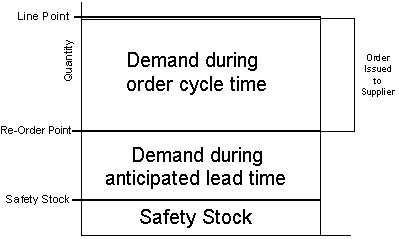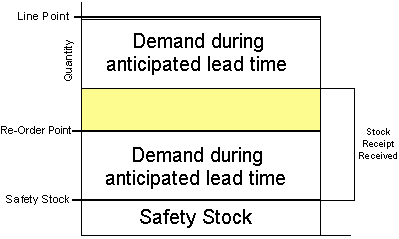About Me
Excel VB Programming (97-2003)
Excel Spreadsheet Formulas
Excel VB.NET Programming
Access Programming (2000-2003)
Material Management
Master Scheduling
&
Production Planning
Demand Forecasting
What is the "right" amount of inventory?
Sales people want larger stock balance that will meet any immediate sales quantity. Purchasing people want to buy in bulk to take advantage of price breaks, lower unit costs and economies of scale. Finance people don’t like huge inventory because it ties down working capital and disrupts cash flow. Your job as material controller is to drive the balance between costs objectives (from Marketing, Purchasing, Finance, Operation/Logistics) and customer’s service level. How do you know if you have too much, too little, optimal, or just the right amount of stock inventory? One way is to compare your current inventory balance to an "ideal” inventory investment, but first you have to separate those inventory items with recurring demand from those items with sporadic usage.
Recurring Usage Items
Products with recurring usage are sold or used on a regular basis. For example, there had been usage in at least 6 of the last 12 months, or had usage in at least 4 continuous months in the last 12 months (this second condition identifies a seasonality pattern of items that are only sold during certain times of the year).
Replenishment of these items is normally based on safety stock quantities, order points, line points, and standard order quantities (Figure 1.1):■ Safety Stock: The buffer added to on-hand inventory that is maintained to protect you from stockout resulting from unexpected customer demand or vendor shipment delays.
■ Re-Order Point: The Safety Stock plus predicted demand during the anticipated lead time.
■ Line Point: The Order Point plus predicted demand during the order cycle with supplier.
 Figure
1.1
Figure
1.1
 Figure
1.2
Figure
1.2
In figure 1.2, if you place replenishment order when the stock on-hand was just below the line point, you ‘d receive the shipment when the available stock quantity has not even reached re-order trigger point (in the yellow block). If you didn't order the item until the stock on-hand equaled the re-order point, theoretically the receipt would arrive when the available inventory equaled the Safety Stock. Therefore it can be estimated that:
Average qty on-hand at time of stock receipt = (Line Point qty on-hand - Anticipated Lead Time Demand) + Safety Stock
The stock receipt of items with recurring usage will normally be equal to the specified Standard Order Quantity (SOQ). The average quantity of this SOQ on-hand during the time it takes to sell the entire SOQ will be equal to half the SOQ. Therefore the ideal average on-hand quantity of an item with recurring usage should be equal to the average quantity on-hand at the time of stock receipt plus half the SOQ:|
[(Line Point qty on-hand - Anticipated Lead Time Demand) + Safety Stock] |
+ |
SOQ |
|
2 |
2 |
You can multiply the ideal average on-hand quantity of each item with recurring usage by its average cost and compare it to the current inventory value of the product to determine whether you are currently over stocked or under stocked.
Sporadic Usage Items
Items having sporadic usage are not sold or used on a regular, predictable basis. You can not estimate the average or ideal value of sporadic inventory items to be some average of the normal quantity on hand, or perhaps some percentage of the target safety stock level. After all, you might have sporadic usage items in stock in excess of the target stock level, and you need to monitor particularly for those items with a high unit cost. It is appropriate to consider the "ideal" value of sporadic inventory items to be equal to the target stock level quantity times the average cost. If you found that you have excess value of some sporadic inventory items, you should consider the following:
■
Discontinue the sporadic usage
items from stock inventory and ordering it only as necessary.
■
Transfer excess quantity to other
stocking locations which will not place new purchase to support the sporadic
usage.
Next Page >>
Reorder Point Technique & Safety
Stock